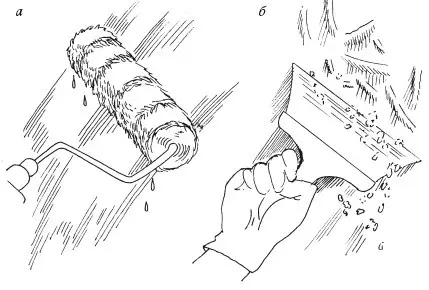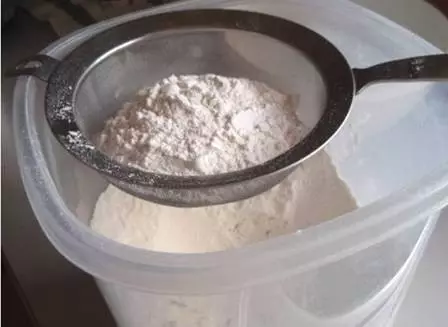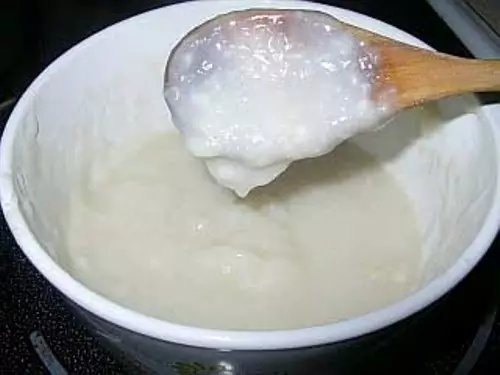Conducting a small cosmetic repair of a room or an apartment often consists in decoration of walls. This is usually a shift of wallpaper. This fact does not surprise, after all, overlapping wallpaper and rearrangement of furniture, you can get an updated room interior, almost without spending money from the family budget. For repair, only finishing materials and special glue will be required.

The composition of the stubble is under the wallpaper.
Today, manufacturers offer a large selection of a variety of glue, but not always it is suitable for certain tasks. So, it is almost impossible to choose an adhesive agent for walls covered with olphoi or oil paint.
This means that cooking glue will have to be on its own, using the components that are in every home.
What is Cleaster and what it consists

Removing old wallpapers from the walls: A - Moisturizing with a roller, b - removing the layer of whipping the spatula.
Another 20-30 years ago, the wallpaper Clauster, cooked from flour or starch, successfully replaced all adhesives for wallpaper offered by modern manufacturers. It turns out that the popularity of the Clays does not fall in our day. Despite some disadvantages, he is willingly used when sticking wallpaper.
The main flaw in the flour is in low moisture resistance. That is why it is not recommended to use in rooms with high humidity, and in normal conditions, wallpaper can come off if it rains in a row on the street. Today, this disadvantage can be eliminated by special additives used during glue cooking.
But the advantages of flour glue has many: it is both environmental friendliness, and no unpleasant smell during sticking of the finishing material, and the ability to easily remove old wallpapers. To clean the walls, it is enough to moisten them with hot water, and the canvas will be twisted without the slightest effort. In addition, the walls will look perfectly clean, because the hubble does not leave the traces and does not require additional processing in front of the new trim.
Article on the topic: Orthopedic mats for children do it yourself
Clauster cooked from flour
High-quality and efficient wallpaper glue can be welded from flour or starch. This adhesive substance will also be useful when making crafts from papier mache or a large amount of paper gluing. What is needed for the manufacture of alee? If you are going to cook with your own hands, use the following recipes and recommendations in which:
- flour (undesirable to use top grade flour, it is better to take 1 or 2 grade);
- water;
- PVA aluminum or carbon black (it will serve as an additive that increases the moisture resistance of the adhesive substance).
The adhesive preparation recipe is extremely simple, and if you choose the ingredients correctly, the glue will be easy to cook:

To avoid lumps and improve the quality of the caustiary prepared, the flour should necessarily sift.
- To prepare 1 l of substance, take 200-250 g of flour. The flour must be sifted: this will avoid the formation of lumps and significantly improve the quality of the challenger.
- Add a small amount of water into flour, and then thoroughly mix the ingredients.
- Before cooking glue, make sure that there are no lumps in the mixture. Then pee in boiling water tank before receiving a volume of 1 liters. Pour the liquid with a thin flowing and constantly mix to exclude the occurrence of lumps. If the holter turned out to be thick, add a few hot water.
- In the resulting mixture, add 0.5 cup of joinery glue or PVA glue. After that, cook the composition on a water bath or a slight heat before the bubble mixes on the surface.
- Remove the mixture from the fire and check for the presence of lumps. If the lumps during cooking did not disappear or, on the contrary, appeared, strain the plumbing through the gauze.
- Give substance to cool. Usually, when a holter is frozen, a thick film appears on its surface. It must be removed.
Cleaster is ready, and it is necessary to use it in the very near future. As noted by experts, the composition is most effective when its temperature equals 40 ° C. Leave the Kleister for a while, and he will lose his adhesive qualities.
Article on the topic: Tool for laying wooden floors
Pleaster cooked from starch
If you are planning a sticking of very thin and easily fatty paper wallpapers, the leaks can be replaced with starch glue. This composition will not leave unwanted spots on the surface of the finishing materials. In order to prepare glue, the following ingredients will be required:
- Starch - 1 kg;
- Water is about 9 liters.
Glue from starch is prepared as follows:

With a wooden stick, the mixture must be thoroughly mixed up to the formation of a homogeneous mass.
- 1 kg of starch is sieved through fine sieve (thus remove small garbage and lumps);
- Starch is poured with a small amount of warm water and gently mixed;
- The consistency of the mixture should resemble liquid dough;
- The prepared mixture is brewed with boiling water, bringing the volume of the substance to 10 liters; boiling water is poured with a thin flowing with a thorough mixing of the mixture;
- The resulting mixture is thoroughly mixed up to uniformity with a stick, then fastened through the gauze and heated in a water bath;
- If necessary, PVA or joinery glue is added to the Clauster.
The resulting composition can be used not only as an adhesive substance, but also for the progress of the walls before sticking finishing materials. There are situations that in one day it is not possible to fulfill all the repair work, and there remains a large amount of unused celastic.
Its storage period can be extended for several days by adding alum or carbolovic acid. The proportions are as follows: on 10 liters of glue - 50 g of alum or 25 g of acid. Before use, the alum must be twisted in water. If an ordinary hitch can be stored no more than 3-4 days, then such a composition can be used in a week.
Taking advantage of the recipe for cooking alert from flour or starch, you can break the wallpaper even on painted surfaces. In this case, you will not pursue the smell of glue prepared from chemicals, and the risk of spots on the wallpaper will be reduced to zero.
Article on the topic: How to make a barn at the cottage: and organize the storage of things (22 photos)
